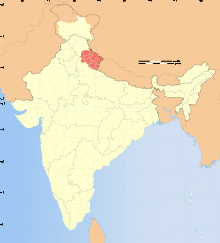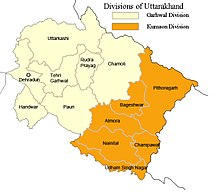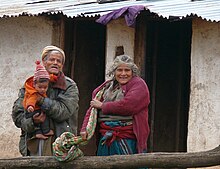Garhwali people
[1] In modern usage, "Garhwali" is used to refer to anyone whose linguistic, cultural, and ancestral or genetic origins is from the Garhwal Himalayas.The earliest reference to this region is in the Skanda Purana which called it Kedar Khand and Himvat.For 12 years the Gurkhas ruled the country with an iron rod, until a series of encroachments by them on British territory led to the Anglo–Nepalese War in 1814.Two battalions of the Indian army (the 39th Garhwal Rifles) were deployed in the area, stationed at the military cantonment of Lansdowne.Srinagar (Garhwal) was the largest city and served as an important trade center along with the town of Kotdwara which is situated at Oudh and Rohilkhand railway tracks.[7] The language has many regional dialects including:[8] Srinagari, Tehri (Gangapariya), Badhani, Dessaulya, Lohbya, Majh-Kumaiya, Bhattiani, Nagpuriya, Rathi, Salani (Pauri), Ravai, Parvati, Jaunpuri, Gangadi (Uttarkashi), Chandpuri.The temple administration body organises several annual events including cultural and religious seminars.It lies at an altitude of around 6,000 feet (1,800 m) (1,800 m) on the river Saraswati in the Himalayas, surrounded by the peaks of Kedarnath in Rudraprayag district of Uttarakhand.This pantheon was headed by Durga and Mahadev, who is referred to by many names such as Bhagwati, Surkanda, Kali, Bhavani, Nanda etc.They also worship their ancestors who were locally known as Bhumiyal, which literally means guardians of Land each and every Garhwali villages have their own Bhumiyal they are worshipped in a small stone made shrine known as Thaan where they are represented by small rocks placed inside the thaan.


GarhwalUttarakhandGarhwaliHinduismKumaoni peopleKhas peopleIndo-Aryan languageGarhwal HimalayasethnonymSkanda PuranaGarhwal KingdomKingdom of GarhwalParmarsAnglo–Nepalese WarSudarshan ShahGarhwal RiflesLansdownePunjab Hill States AgencyBritish IndiaUttarkashi districtUnion of IndiaRamayanaMahabharataGarhwali languageCentral Pahari languageIndo-Aryan languagesTehri GarhwalPauri GarhwalUttarkashiChamoliDehradunHaridwarRudraprayagmoribund languagesChota Char DhamYamunotriGangotriKedarnathBadrinathUmra NarayanKoteshwar MahadevDhari DeviKalimathBhasmasurShakta pithasJagar (ritual)NarsinghBhairavNagarajaKrishnaPandavDraupadiMahadevBrijendra KalaChitrashi RawatDeepak DobriyalHimani ShivpuriPriyanshu PainyuliSanjay KhanduriTigmanshu DhuliaUrvashi RautelaVarun BadolaAnushka SharmaTripti DimriJagat RawatMadhurima TuliAditi SajwanAlka KaushalAsha NegiBarkha SenguptaPriyanka KandwalRaghav JuyalRicha PanaiShivangi JoshiShruti BishtShruti UlfatAbhilash ThapliyalAnukriti GusainFemina Miss IndiaMiss Asia Pacific WorldManasvi MamgaiNavi RawatBasanti BishtPadma ShriChander Singh RahiJeet Singh NegiMeena RanaNarendra Singh NegiSangeet Natak Akademi AwardPritam BhartwanAbodh Bandhu BahugunaGanga Prasad VimalLeeladhar JagudiSahitya Akademi AwardManglesh DabralMola RamIndian painterPahari/Kangra school of paintingRanbir Singh BishtLucknow UniversityLalit Kala Akademi FellowshipTaradutt GairolaViren DangwalGirish TiwariShekhar PathakChipko movementAnil Prakash JoshiPadma BhushanChandi Prasad BhattRamon Magsaysay AwardGaura DeviIndira Priyadarshini Vrikshamitra AwardKunwar Singh NegiSunderlal BahugunaPadma VibhushanNagendra SaklaniRam Prasad NautiyalSri Dev SumanTeelu RauteliDabral BabaHans MaharajPrem RawatDivine Light MissionSwami RamaAnand Sharan RaturiMahatma Jyotiba Phule Rohilkhand University